The Alocasia ‘Black Velvet’ (Alocasia reginula) is a popular miniature jewel alocasia with characteristic dark foliage and a compact growth habit. Named for both its regal appearance and black velvety leaves, which are contrasted beautifully by the piercing white venation.
Truly, a real dark gem of a plant.
As part of the very exclusive club of plant species with (almost) black foliage, Alocasia reginula ‘Black Velvet’ makes a striking statement wherever you put it.
Which – as a surprisingly versatile plant – is actually a lot of places.
Overall, Alocasia ‘Black Velvet’ are relatively straightforward to care indoors and in glass, but they do have some important watering nuances that you need to know in order to protect their roots and keep them healthy.
So read on to find out!
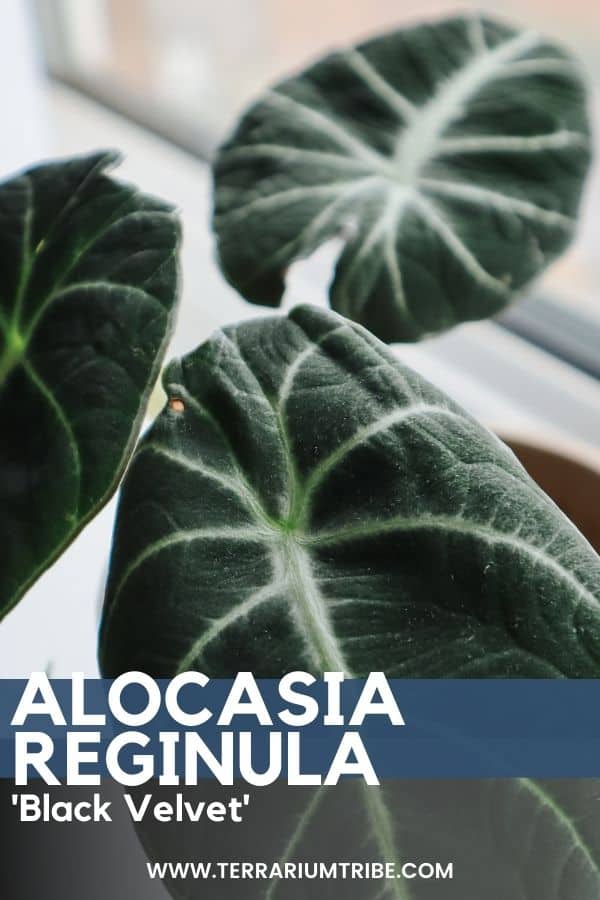
Alocasia Black Velvet Benefits (& Royal Intro)
Native to the jungles of Borneo, Alocasia reginula ‘Black Velvet’ is a tropical plant with a truly regal name.
Not just the ‘Black Velvet’ name (which of course sounds incredibly luxurious) but even the botanical name Alocasia reginula literally means the “little queen”.
Honestly, I think the foliage of this plant really does the name justice, though we call ours Alannah for the classic song that bears its name…
Known as one of the “jewel alocasia,” this plant is destined to stay small, sweet and classy throughout its life – making this plant super accessible to terrarium lovers and indoor plant parents alike.
With silvery veins piercing through black velvety leaves, it provides a powerful contrast to a typical green backdrop – making Alocasia ‘Black Velvet’ an excellent focal piece!
Where to Find Alocasia Black Velvet for Sale
See the links below to purchase from reputable terrarium plant shops and marketplaces (may include affiliate links).
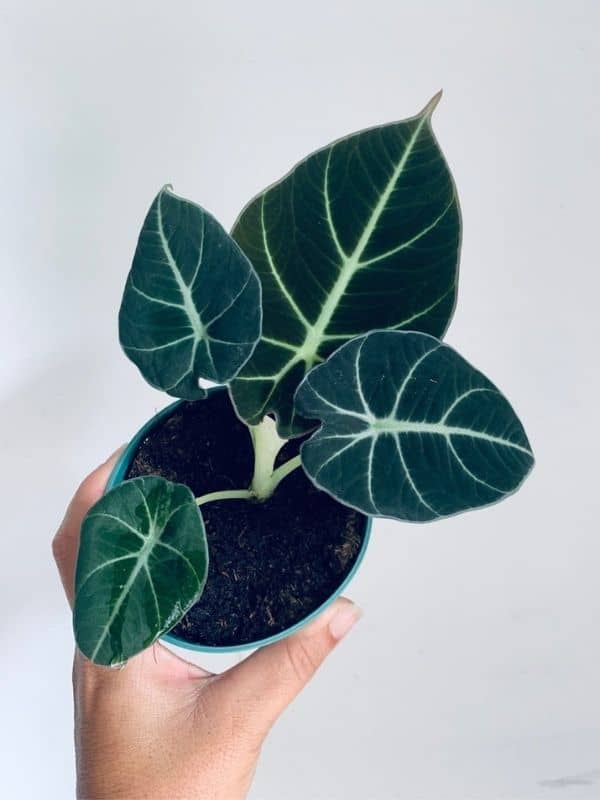
Alocasia Black Velvet Indoor Care
At a Glance
| Plant Type | Foliage |
| Lighting | Bright indirect light |
| Temperature | 55-86°F (12-30°C) |
| Watering | Infrequent, moderate moisture |
| Humidity | Medium – high humidity (40-70%) |
| Growth | 10-15 inches |
Lighting Conditions
Found on the jungle floors of its native countries, Alocasia ‘Black Velvet’ loves to bask in the dappled sunlight that’s able to break through the canopy.
In the home, this means Alocasia ‘Black Velvet’ will thrive in a bright spot with lots of indirect light.
North-facing windows are a good bet for guaranteed indirect light, but East-facing can work, too, as long as the morning sunlight isn’t too strong.
Personally, I have mine about 7 feet from our South-east window.
Near the window, the sunlight would definitely be too much, but ours is happy here just outside of the direct light. She’s doing much better there, as you can see she was getting a little leggy before (from her previous position much farther back in the room).
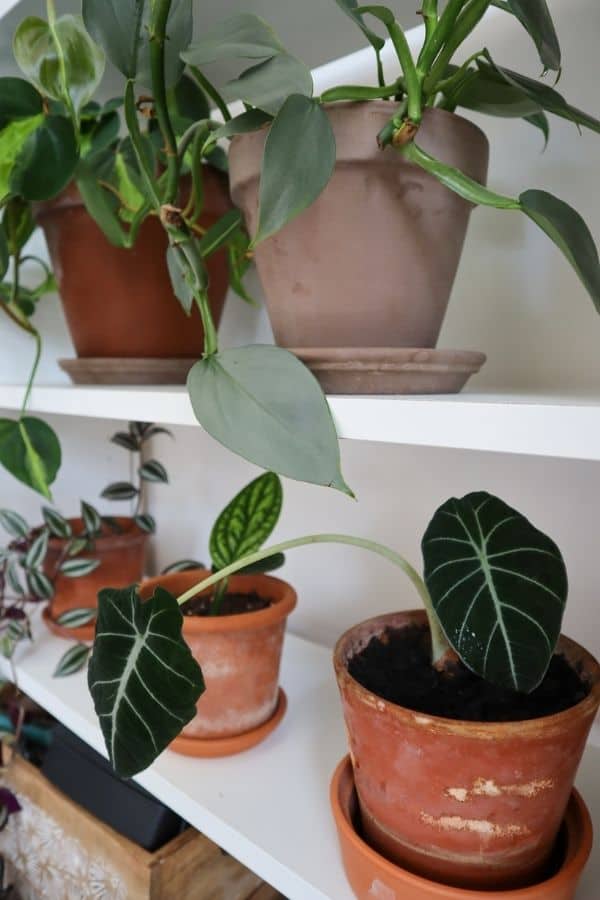
That being said, their dark leaf pigmentation suggests they’re able to cope with lower light levels to some extent.
So feel free to experiment a little.
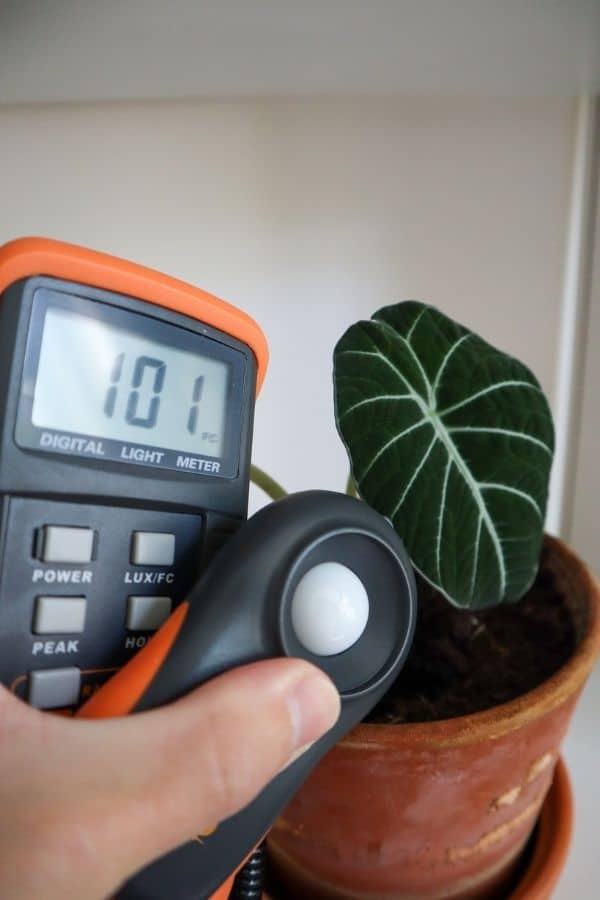
I’ve found that they’re able to handle a small amount of direct sunlight in the winter months, but you’ll soon start to see their leaves start to curl if the light is too harsh.
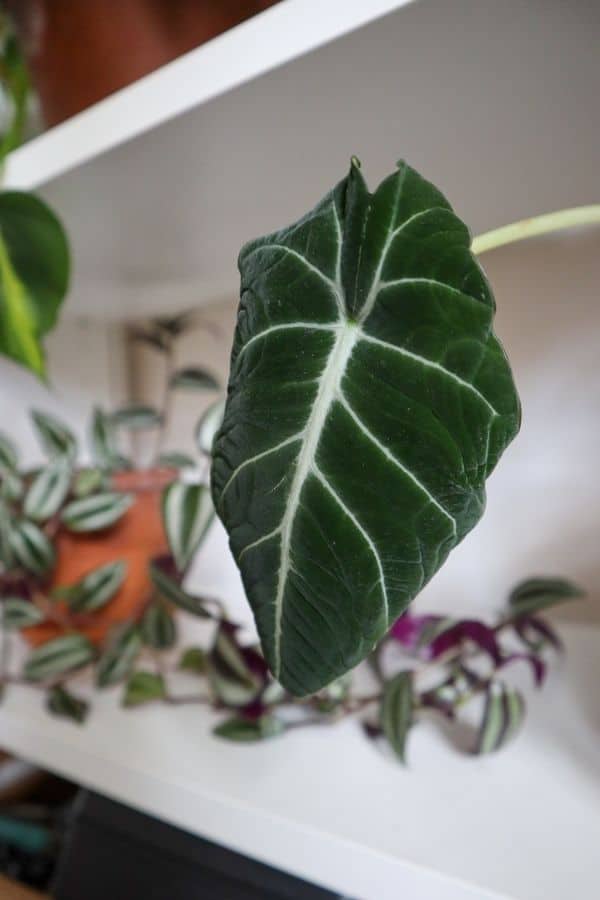
As a plant naturally found on the rainforest floor, it’ll do well under the shade of other nearby plants, so feel free to group your Alocasia with some friendly foliage on the shelf or in your terrarium!
Watering
Alas, it can be all too easy to over-water Alocasia reginula ‘Black Velvet’.
It’s not that Alocasia plants don’t love water (as tropical plants, they most certainly do); it’s more that they have a surprisingly low tolerance for consistently wet environments.
I can relate…
The thick leaves of this Alocasia hint at its moisture-retaining abilities, but really, it’s the rot-prone roots that dictate its watering needs.
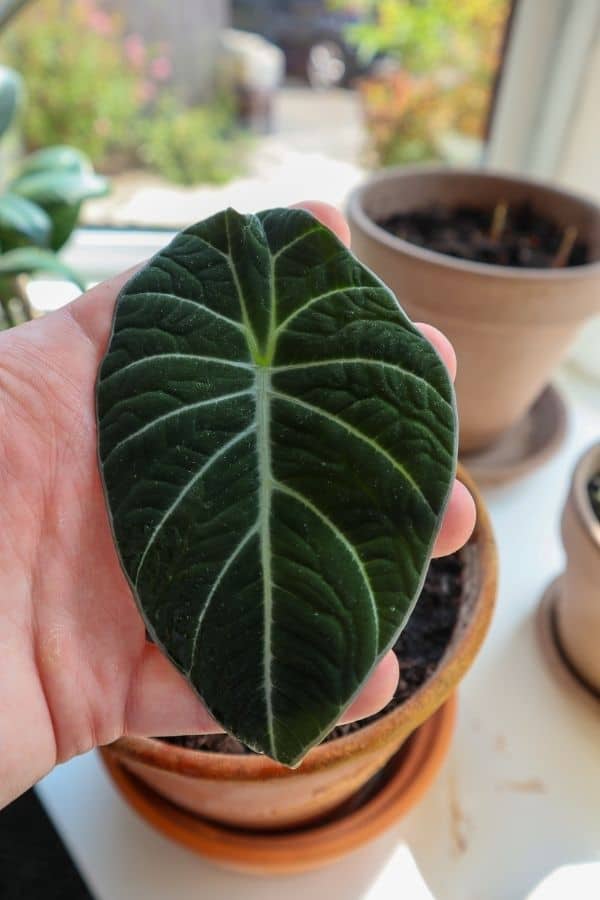
So, there are two components to getting your watering right:
- Add water only when your substrate is dry to the touch (in terrariums, this means achieving a moisture balance with minimal water input).
- Whether you grow this plant in a pot or a terrarium, proper drainage is essential. That means both somewhere for the water to drain to (via a hole or drainage layer) and having an appropriate soil/substrate that the water can drain through.
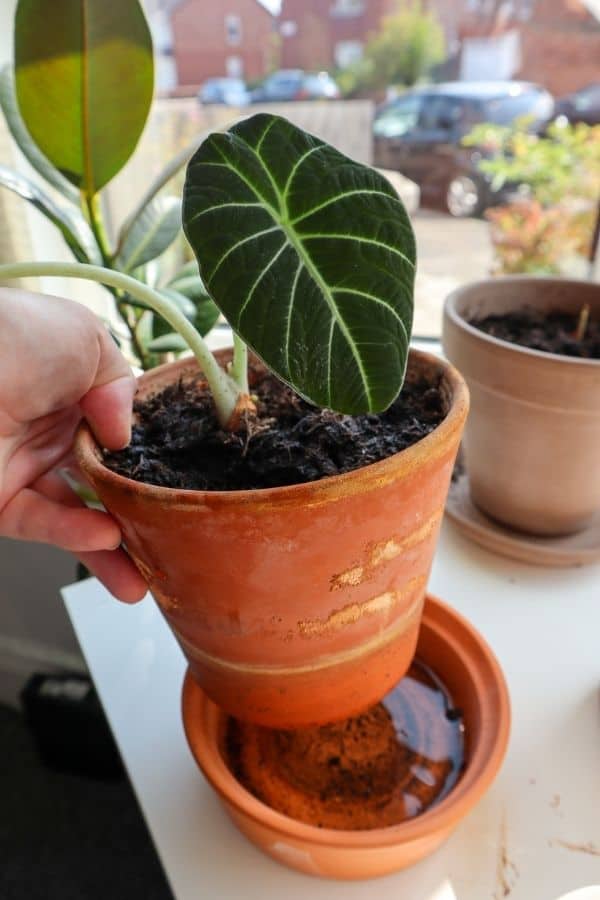
Soil / Substrate
Using a substrate with good drainage is important to prevent this plant from developing root rot, but thankfully, most tropical mixes are designed to do just that (e.g., ABG mix).
Opting for a granular mix high in orchid bark and sand will help to provide the necessary drainage and root aeration, and you can supplement with additional pumice or vermiculite as necessary.
However, I’d recommend you also reduce the sphagnum moss and coco coir content from your typical tropical mix, as you won’t need quite as much water retention with Alocasia ‘Black Velvet’.
Temperature & Humidity
As a commonly grown indoor plant, Alocasia reginula ‘Black Velvet’ will comfortably grow in most household conditions.
That being said, for a tropical species that doesn’t like overly moist soil, it really does appreciate a higher humidity and temperature.
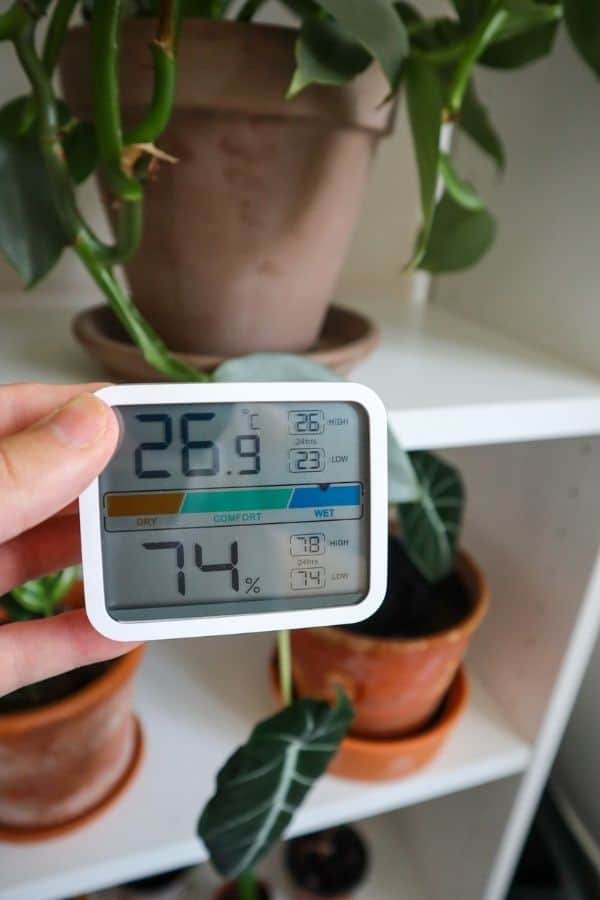
Really, you’ll need a humidity level of 50%+ to really keep them at their happiest, but that should be easily achieved with a pebble tray, humidifier, or closed terrarium.
Having a tonne of plants together helps, too…
Also, Alocasia Black Velvet isn’t particularly cold hardy, so you’ll want to make sure they aren’t anywhere near a cold window in the Winter months.
If it’s too cold for you to sit near it, you can be sure it’s too cold for your Alocasia!
Growth & Flowering
As a jewel alocasia, you can expect this species to grow at a slow rate and stay pretty compact even when fully mature.
Alocasia Black Velvet, fully grown, is still only going to be just over a foot tall.
Personally, I’ve found that this plant will often allow its older leaves to die off in favor of creating new ones – so that can really slow down the whole growth process too.
They’ll occasionally bloom with a simple white flower, but it’s not much to look at.
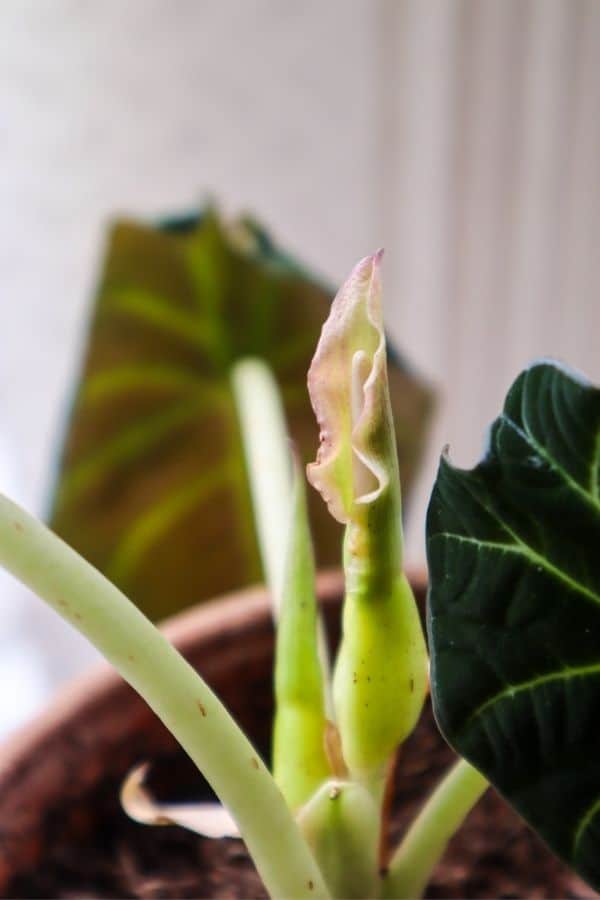
Some natural fertilization (e.g., earthworm castings) can help get your Alocasia off to a good start, but they’re unlikely to need any further supplementation.
They’re also quite happy being slightly root-bound, so you’re probably not going to need to repot them much, and they’ll fare well in fuller terrariums.
Propagation
Alocasia won’t grow from stem or leaf cuttings, but you’ll find they’re often a group of plants clumped together that you can divide, or they naturally form new baby plants anyway.
So, the easiest way to propagate Alocasia reginula ‘Black Velvet’ is to expose the central rhizome, identify any offsets, and remove them with your hands or a clean knife if necessary.
These can be planted up as they are.
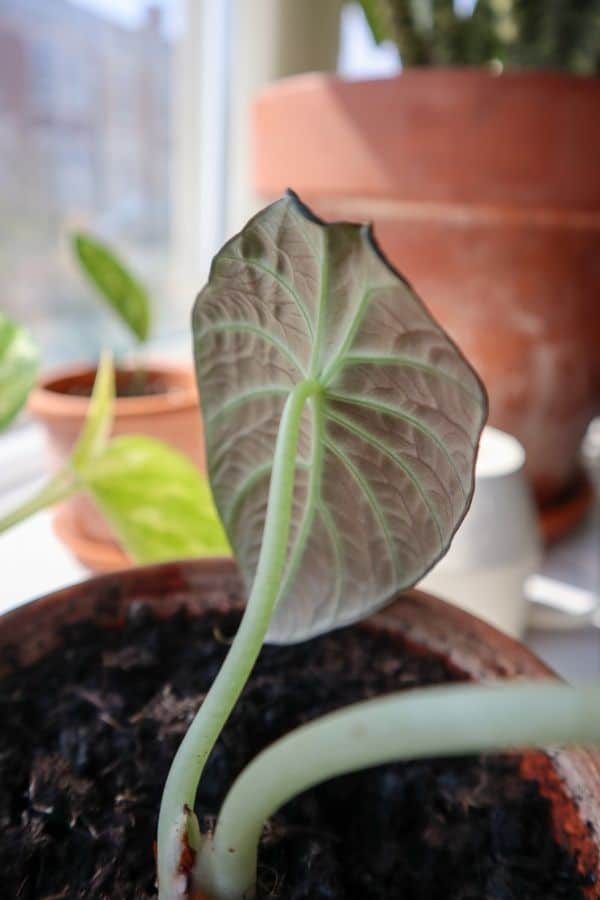
Varieties & Similar Plants
Several of the other jewel alocasia varieties are excellent candidates for terrariums, including Alocasia baginda ‘Dragon Scale’ and Alocasia cuprea ‘Red Secret’.
There is a green velvet alocasia (Alocasia micholitziana ‘Frydek’), but it’s much larger and comes with green foliage and more of a serrated arrowhead-shaped leaf.
Alternatively, there’s a new hybrid Alocasia that’s a mix of the Black Velvet and the Melo – Alocasia maharani!
Common Problems
By far the most common problem in growing Alocasia reginula ‘Black Velvet’ is over-watering. However, through careful watering and use of a well-draining substrate, you can certainly get the moisture balance right.
As with other Alocasia, this plant can be prone to spider mites if you’re growing it in a pot. So, quarantining any new plants is always a good idea before adding to a terrarium.
That being said, a higher humidity is one of the most effective ways to combat spider mites, so crank up the humidity and moisture to keep your plant happy and those pesky mites off.
Frequently Asked Questions
Curling leaves is usually a sign of too much light, but it could also be conflated by underwatering.
Typically, yellowing leaves can be a sign of both underwatering and overwatering plants (unhelpful, I know). Though, in the case of Alocasia I’d say it’s more likely to be the latter, so if you’re watering often then try pairing it back a bit.
It’s common for healthy Alocasia to lose leaves as they mature, so it’s often nothing to worry about. They like to sacrifice older leaves so they can supply all their nutrients to newer, bigger leaves. It’s all part of the process!
Yes, unfortunately Alocasia Black Velvet is indeed toxic to both animals and humans.
Brown tips on Alocasia Black Velvet are typically caused by either fertilizer burn or underwatering. If the leaf tips are dry and crispy too, then it’s likely to be underwatering.
